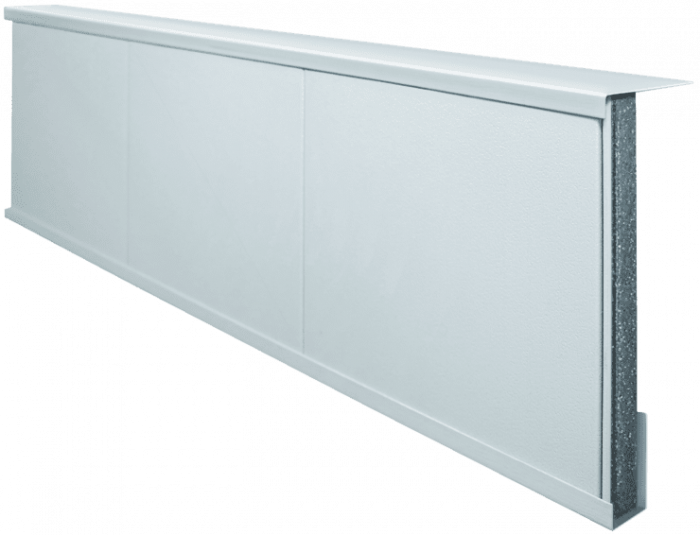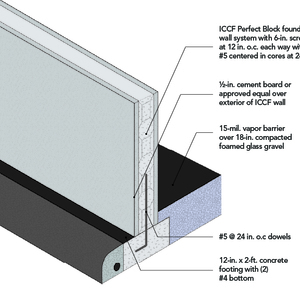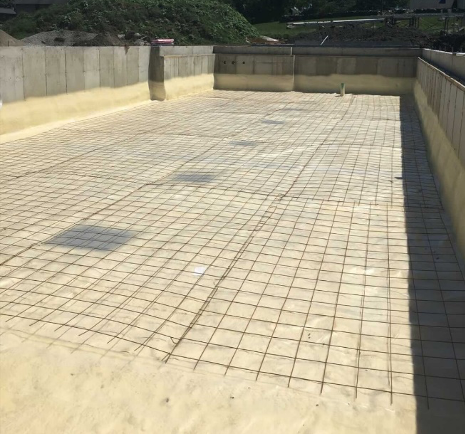
Because exterior insulation places the foundation wall within the thermal envelope, this approach offers several advantages over insulation in the interior. To start, continuous exterior insulation avoids thermal bridges and protects and maintains the basement waterproofing. It also minimizes moisture condensation problems and, perhaps most importantly, does not reduce the interior basement floor area.
Despite the advantages, builders still prefer to place the insulation inside the basement walls. This location avoids the main downside of the exterior placement, namely, covering the foam to protect it from ultraviolet sun rays and whipping weed-eaters. As an advocate of exterior foam insulation, I have resorted to protecting above-grade foam with an aluminum coil, fiber-cement board, and parging with an EIFES finish coat. One problem with most of these finishes is that the manufacturers do not recommend them at or below grade. The other is labor. It takes time to add this special step to the construction process.

Warm basement walls
All exterior foundation insulation materials must be approved for below-grade use. Only three types qualify, including extruded polystyrene, expanded polystyrene, and rigid mineral fiber panels. The FoundationPRO, “one-piece insulated foundation finish system,” is made with Neopor, an expanded polystyrene insulation with added graphite. The manufacturer laminates this material with PVC, or a “thick polymeric shell,” affixed with a permanent polyurethane adhesive. The system includes color-coordinated aluminum channels to hold the top and bottom of each panel in place. Right now,…
Weekly Newsletter
Get building science and energy efficiency advice, plus special offers, in your inbox.

This article is only available to GBA Prime Members
Sign up for a free trial and get instant access to this article as well as GBA’s complete library of premium articles and construction details.
Start Free TrialAlready a member? Log in















17 Comments
Thanks, but I'll stick to using plain old untreated EPS on the interior of frost walls. No addition plastic or toxic chemicals needed.
The drawing shows a footing that, if you're doing a full foundation, will wick up moisture that will end up in your basement. The alternative is to use foil faced polyiso which will keep the moisture in the concrete.
I'm trying to build healthy homes. I understand that these chemicals are protected from humans by the plastic covering, but why even go there? And who needs these chemicals around their house?
Here's a small portion of the chemical's label:
KEEP OUT OF REACH OF CHILDREN
WARNING PRECAUTIONARY STATEMENTS
Do not contaminate water, food or feed by storage or disposal.
PESTICIDE STORAGE: Store in a cool, dry place and in such a manner as to prevent cross contamination with other pesticides, fertilizers, food, and feed. Store in original container and out of reach of children, preferably in a locked storage area.
PESTICIDE DISPOSAL: Pesticide wastes are toxic. Improper disposal of excess pesticide, spray mixture, or rinsate is a violation of Federal Law. If these wastes cannot be disposed of by use according to label instructions, contact your State Pesticide or Environmental Control Agency, or the hazardous waste representative at the nearest EPA Regional office for guidance.
CONTAINER HANDLING: Nonrefillable container. Do not use or refill this container. Offer for recycling if available or offer for reconditioning if appropriate. Do not use container in connection with food, feed, or drinking water. Completely empty container into the processing equipment. Then dispose of empty container in a sanitary landfill, by incineration or, if allowed by State and Local authorities, by burning. If burned, stay out of smoke.
Handle and open container in a manner as to prevent spillage. If the container is leaking or material is spilled for any reason or cause, carefully sweep the material into a pile and dispose of as directed for pesticides as above. Refer to Precautionary Statements on label for hazards associated with the handling of this material. In spill or leak incidents, keep unauthorized people away.
HAZARDS TO HUMANS AND DOMESTIC ANIMALS
WARNING May be fatal if swallowed or inhaled. Do not breathe dust or vapor. Wear a mask or respirator jointly approved by the Mine Safety and Health Administration and the National Institute for Occupational Safety and Health. Wash thoroughly with soap and warm water after handling and before eating, drinking or using tobacco products. Remove contaminated clothing and wash before reuse.
NOTE TO PHYSICIAN: No specific antidote is available.
The last sentence should make you feel safe, right?
Bob,
I'm not sure your fears are warranted. EPS / PVC / pesticides have been used for ages and this system is already separated from the interior by nothing short of 6 inches of concrete. Where's the damage to the body going to come from, in comparison to the water arriving at your tap?
The real life potential damage caused by this system has to be weighed against the energy saved and reduction in waste / pollution over the lifespan of the structure, and unless you're eating handful of the foam, after digging it out of the ground, I think that risk is low.
Why not compare it to installing it inside that same wall, where it needs no PVC or toxins and the risk is nil? And I think we're already paying for decades of pesticide use.
If nothing else, I would think that one should consider what happens to the dust produced when this is cut. If it's cut with a circular saw, you'd at least want good dust collection.
There's no health risk with installing PVC. This is misleading. Plumbers, deck builders, window installers, and flooring contractors install, cut, and use PVC daily without ill effects. Health hazards associated with the manufacture or blurring of the material are not present when you use it at the construction site. Hospital interiors, the Apple Store, Google stores, your automobile interior are all PVC. Medical equipment is PVC. Nobody is getting sick from using PVC building materials. They are hypoallergenic. Sorry for the comment, but the misinformation directed at the one material by the same folks that use portland cement, fiber cement, OSB, and other products with a much higher environmental impact than vinyl. Especially at the exterior and buried. The foam used at the interior in sheets of applied foam COULD have a highly toxic effect in a fire. Keep it outside.
It wasn't very clear, but I'm pretty sure Bob's referring to the pesticide in the foam, not the PVC. Here's the label with the statements he quotes:
https://www3.epa.gov/pesticides/chem_search/ppls/039967-00080-20140711.pdf
A little of topic, but what's going on with the steps in the foundation walls? it looks like the footings are not continuous where they step down and there is a void above in the stem wall.
Yes, Charlie, after rereading I see you're correct. I'll try to get some information on this relative to the specific material -- does it leach out, etc. All these things are under heavy regulation, so I presume it's within the normal limits of other biocide materials we use, such as treated plates, fence posts, and decking.. But it's a question worth asking. I'll report back!
Thanks Fernando. I'll be interested to hear what they say. I would assume it doesn't leach out, but turning it into sawdust certainly spreads it around.
Some green builders aren't satisfied being "within the normal limits," and want to reduce toxicity, for local ecosystems, for workers at the plants that make the stuff, and for their clients who are asking that of them. Other still legal pesticides are causing bee colony collapse, for example. So it's worth understanding at least.
Taylor, the shallow slab foundation indeed has steps. These occur in two locations, where the footings are in the non-heated garage, they go down below frost level, in this instance 44-inches. This is what you see in the photo. I also used deeper footings along the shoreline to avoid the shallow foundation becoming undermined during a flood. Stepped footings are also commonplace on walkout lots. The foundation walls (stem walls in this case) act as a beam.
Fernando,
I guess it's a regional practice. I just hadn't seen it done that way. Our code mandates the footing and walls be continuous at steps and that each step not exceed 2 ft.
Anyone been able to get pricing on this stuff?
Please contact me:
Scott Partlo
National Sales Manager-New Construction
Mobile: 330-600-4369
[email protected]
6753 Chestnut Ridge Road
Beach City, OH 44646
Toll Free 800.860.3626
Fax 330.756.3206
Good morning,
Comments from the manufacturer:
Neopor® GPS is a premium construction grade, graphite-enhanced polystyrene (GPS) insulation from BASF®. It is well-known for its specially embedded graphite particles that reflect heat radiation to reduce heat loss.
It is also known for its high performance in the area of moisture management. To prove out these characteristics, BASF commissioned a series of tests conducted by an independent laboratory to test its performance in response to extreme environmental conditions. Neopor GPS proved itself in a number of key areas:
• Held its R-value after 48 days of extreme environmental testing
• ASTM C1512 testing showed that it does not retain moisture and dries quickly when cycling from low to high humidity and wet to dry conditions.
• Retained its physical properties after exposure to extreme environmental cycling
Neopor is a trademark of BASF SE.
In relevant parts of the U.S. code requires builders to address insulative solutions while also taking action against termite infestation and degradation. Unprotected construction materials can be susceptible to termite damage over time and responsible manufacturers should take reasonable precautions.
Preventol® TM* Insecticide is a product used for the control of insects that infect wood and wood composites in above-ground and in-ground applications.
Preventol TM complies with the 2012 and 2009 International Building Code© (IBC), and 2012 and 2009 International Residential Code© (IRC). As noted in ICC-ES Evaluation Report ESR-2918 (reissued September 2021), Preventol TM is used to treat expanded polystyrene foam (EPS) to provide protection against termites in accordance with 2012 IBC Section 2603.9 (2009 IBC Section 2603.8) and IRC Sections R316.7 and R318.4.
Preventol TM is registered with the EPA. The insecticide is encapsulated within the foam and represents no hazard to humans, animals, or the environment when handled or installed in accordance with standard construction practices.
In addition to being commonly used in construction products, the active ingredient is also used in flea, tick, and mosquito protection products for dogs.
Preventol TM is a registered trademark of Lanxess Corporation.
Scott Partlo
National Sales Manager-New Construction
Progressive Foam Technologies
Mobile: 330-600-4369
[email protected]
6753 Chestnut Ridge Road
Beach City, OH 44646
Toll Free 800.860.3626
Fax 330.756.3206
Scott, thanks for joining the discussion here. I'm unsure about the safety of Preventol, particular when cut outdoors with a circular saw. I appreciate your providing some information, but what you said here does very little to address those specific questions.
When you say that Preventol "represents no hazard to humans, animals, or the environment when handled or installed in accordance with standard construction practices," does that include cutting it with a circular saw or table saw and letting the dust blow around the construction site? How is it still "encapculated in the foam" at that point? Are you really claiming that specific approach is OK, and what's the basis for that assessment?
When you say it represents no hazard to animals, are you including insects in the category of animals? I would think not, as the whole point of an insecticide is to kill insects. So what type of animals are you including there? And again, on what basis are you making this claim?
You report testing to support your claims about GPS performance, even though there's no reason to doubt that--It's well known as a favorite insulation type of many of us here at GBA. But what's the basis for the claims about Preventol safety?
Charlie,
I totally understand your concerns and I am not sure that I can provide further information at this time. I too am very concerned about bee and butterfly populations and I will do some research on this and try to get back to you. On a personal note I have planted several butterfly habitats on my property and plan to add beekeeping to my activity in the spring. The above was a response I posted from Progressive Foam.
My personal thoughts are: Years ago we used a borate based treatment for termites in our products. Several years later we moved to Preventol . Among the reasons why were it's safety and effectiveness. Because of it's safety we do not require our plant personnel or installers to wear any type of PPE.
On an unrelated note our products have a far lower impact on the environment in general. Mainly as it relates to carbon foot print (embodied energy) and water usage. Our plants also repurpose all foam waste so no plastic goes to any landfills or anywhere else. I am not trying to deflect from your main concern but wanted to mention this.
The reason I feel that Preventol is important is because we know that foam in general is susceptible to insect derogation and our products are almost always placed in assemblies that are in the path of termites. While I realize that there are other ways to protect foam from termites they are cumbersome to install and add cost and steps to the building process.
In a large part of the U.S. builders are required by code to treat foundations for termites.
I know that a saw may be the preferred method to cut foams but you can score it with a knife and it will snap. To cut FoundationPro you could cut a shallow line through the vinyl skin and the product will snap fairly cleanly. I have also seen heavier utility knives cut the through the skin.
My appeal to you and other readers would be to weigh out the trade offs and then decide what's best for your customers.
As far as moisture management goes I have attached the document that discusses moisture cycling in Neopor published by BASF. There is also some great information published by the EPS Industry Alliance. I have attached that document as well.
All that said I will try to do some further research and try to better address your specific concerns.
Thank you, Scott. It really helps when the manufacturer -- especially such a thoughtful one -- chimes in. Many times the writer does not have all this information and you'd be surprised to learn how often I send comments with the hopes a manufacturer will clarify and they do not. So again, thank you.
Log in or become a member to post a comment.
Sign up Log in